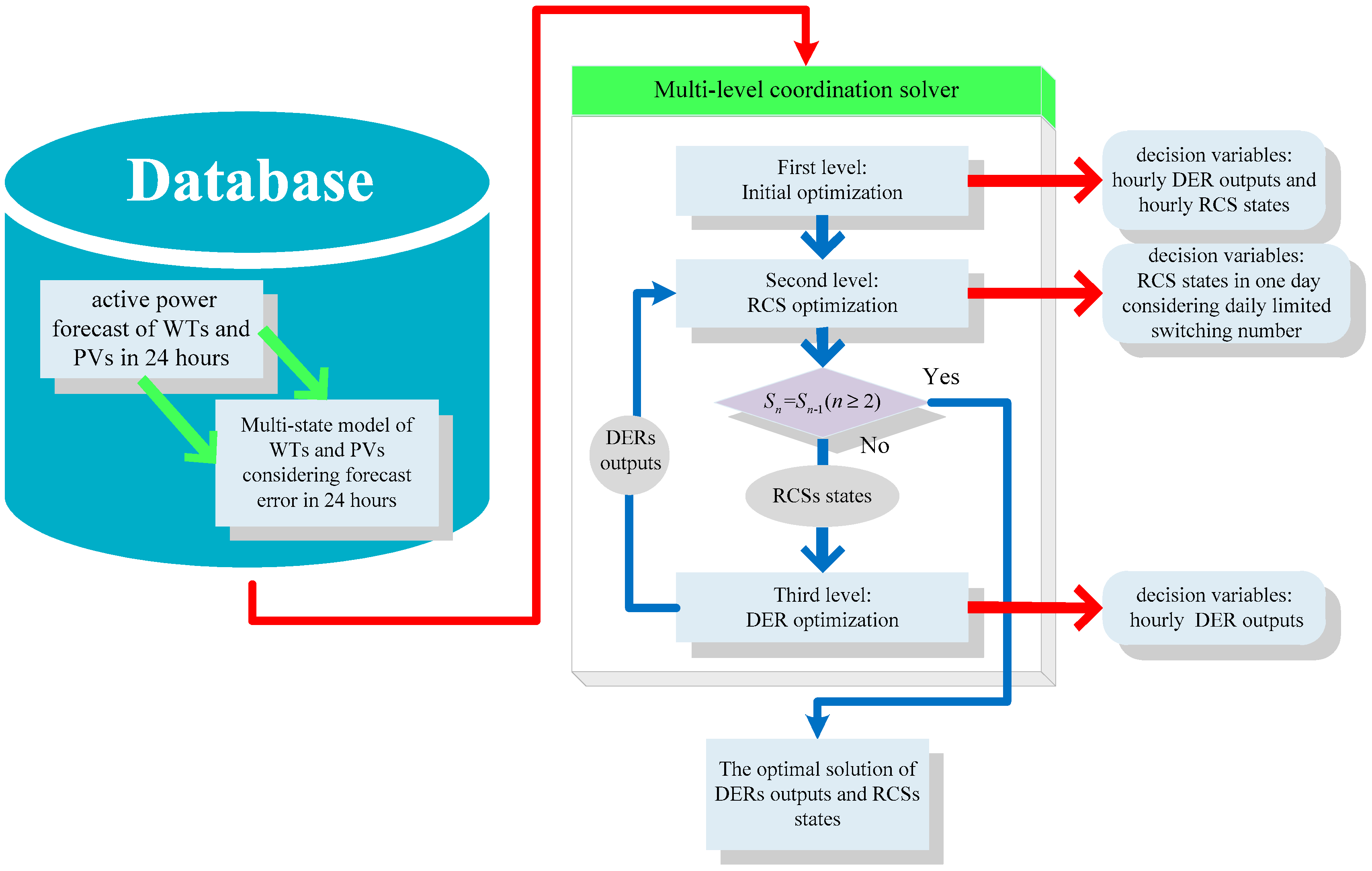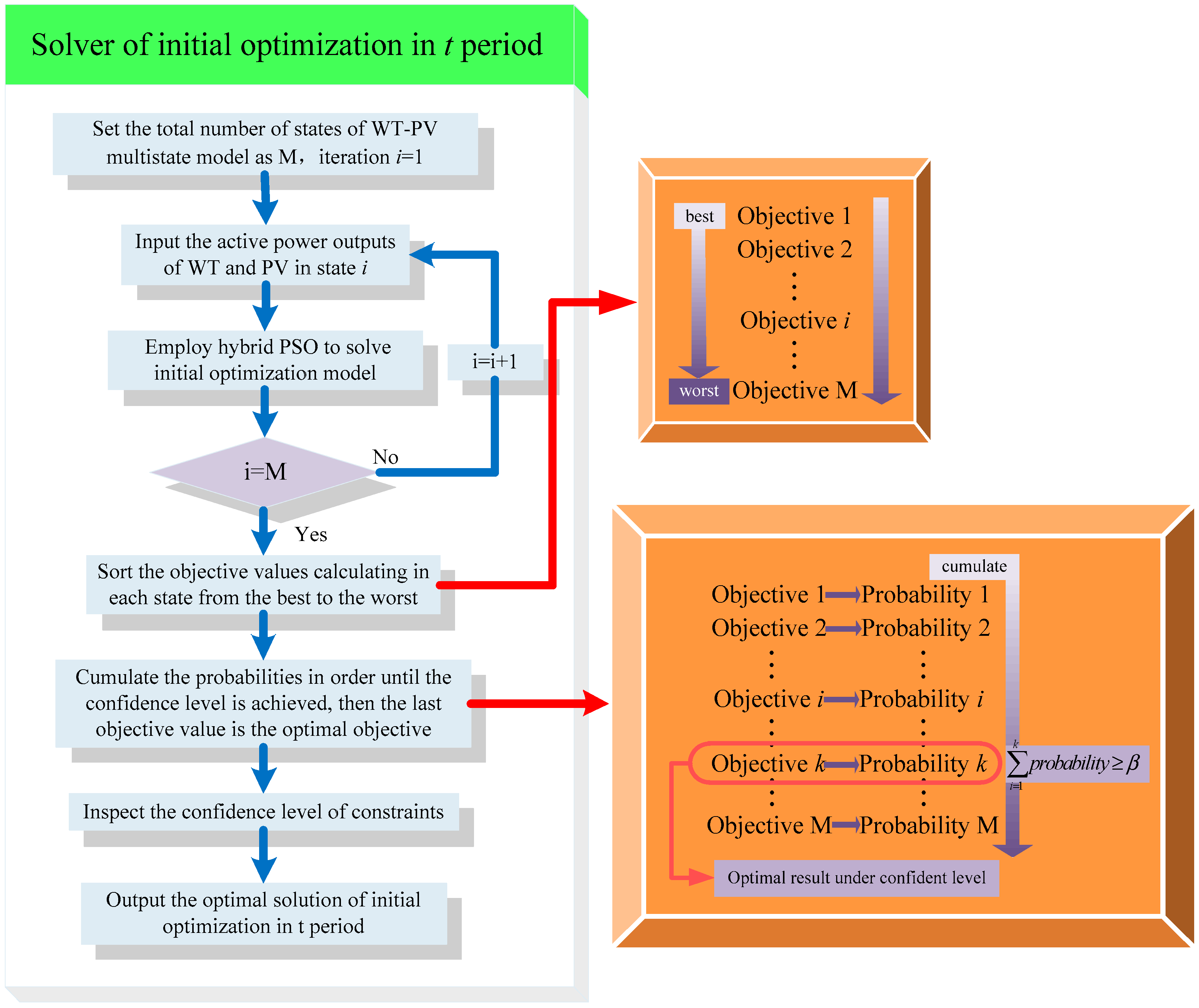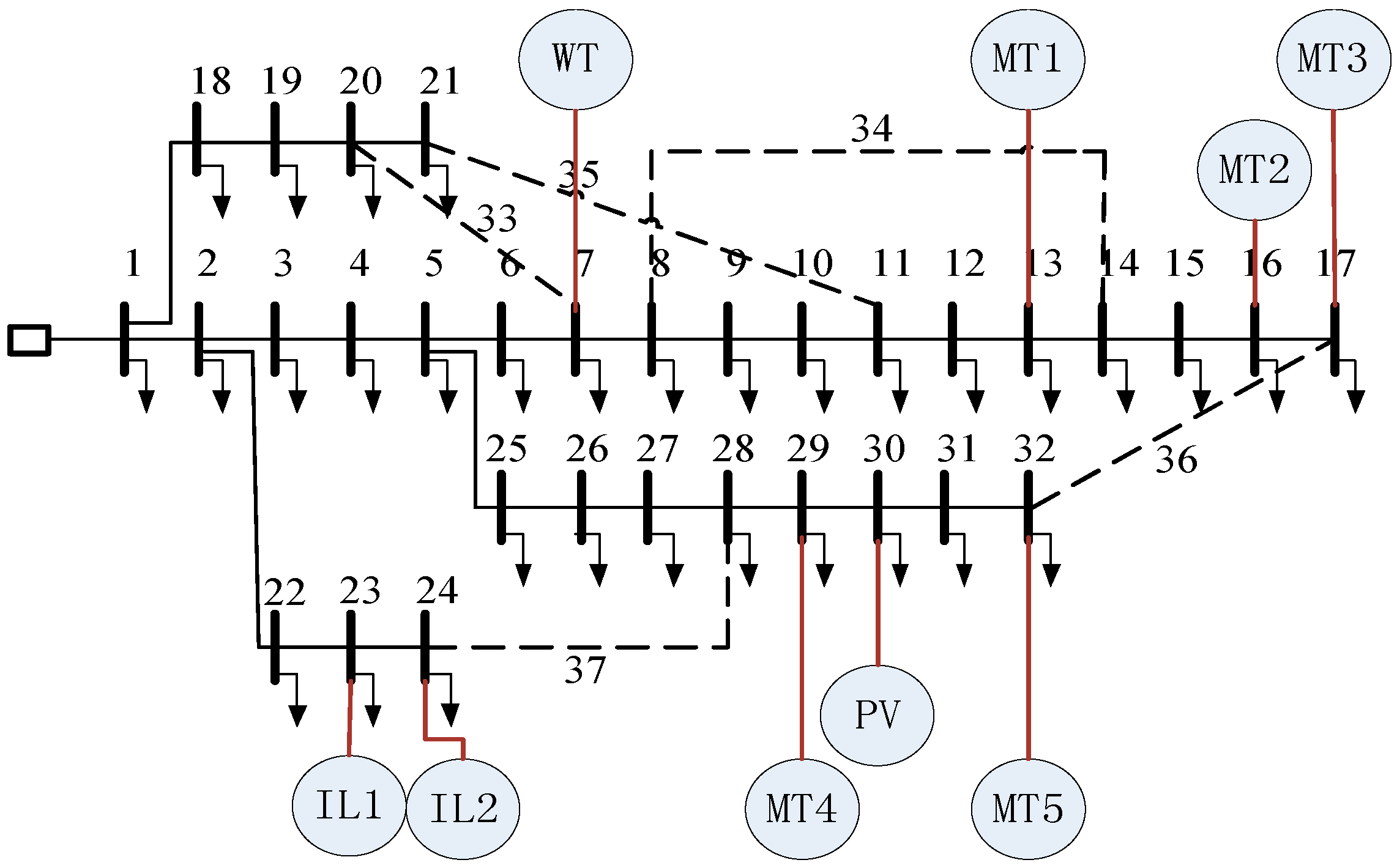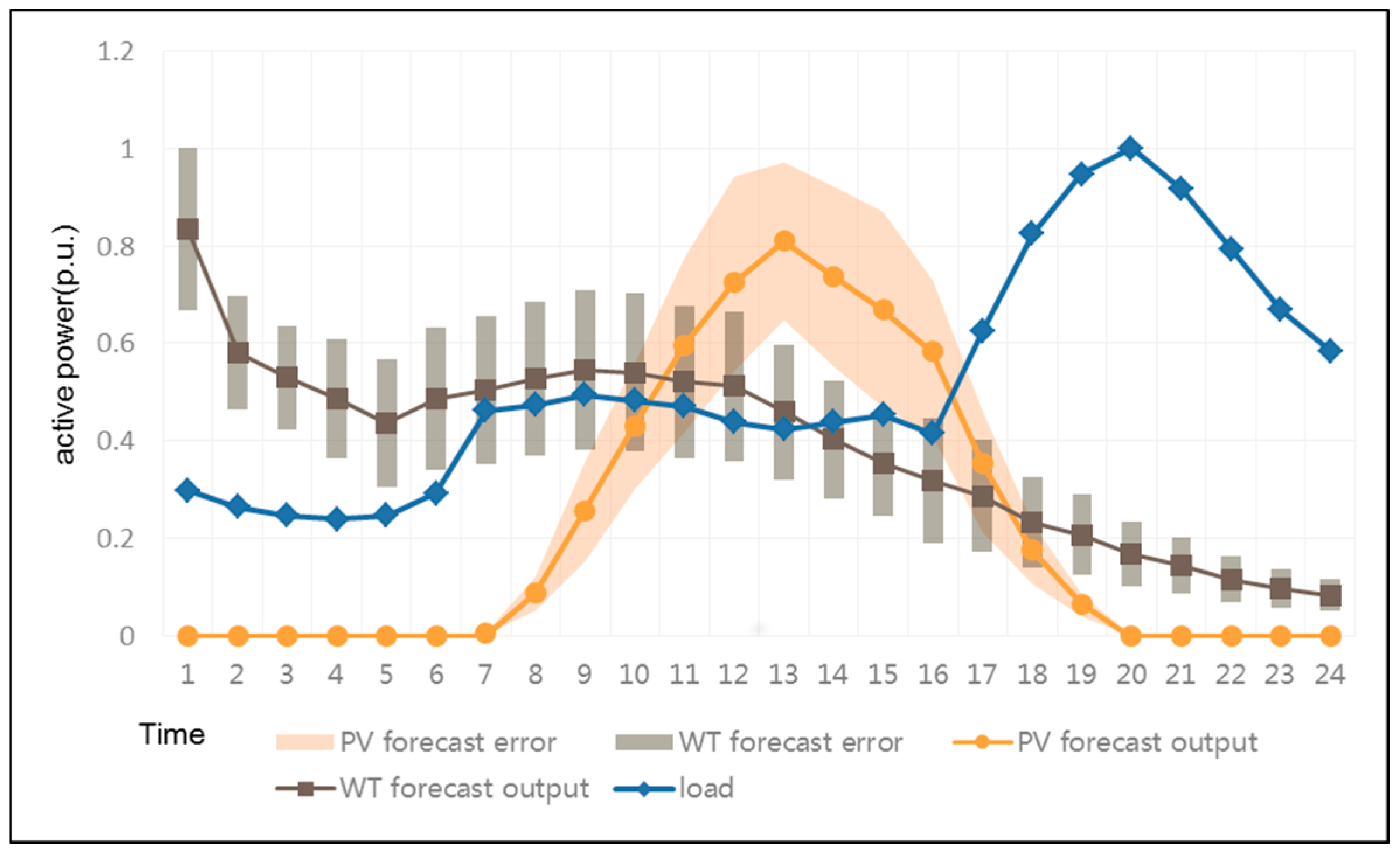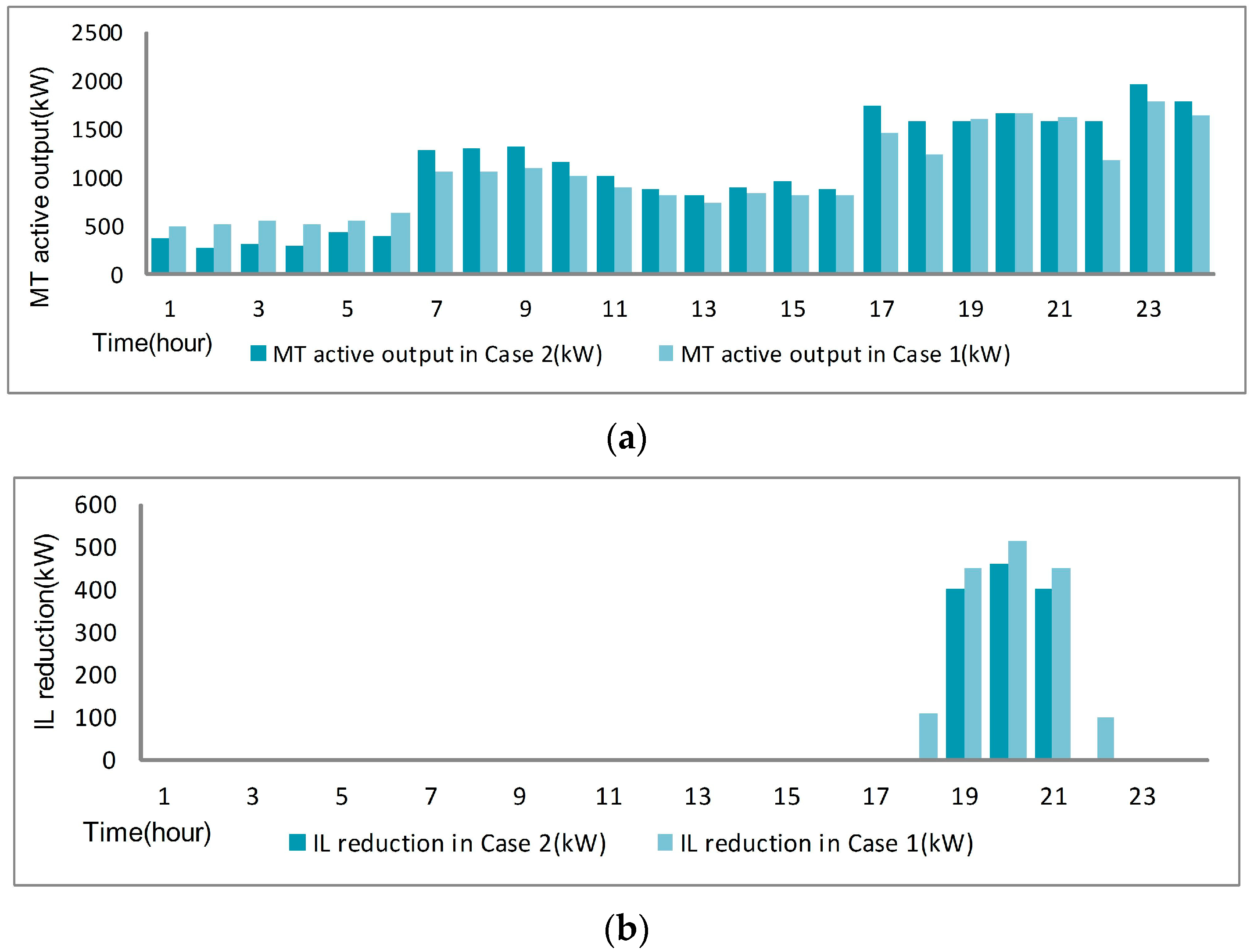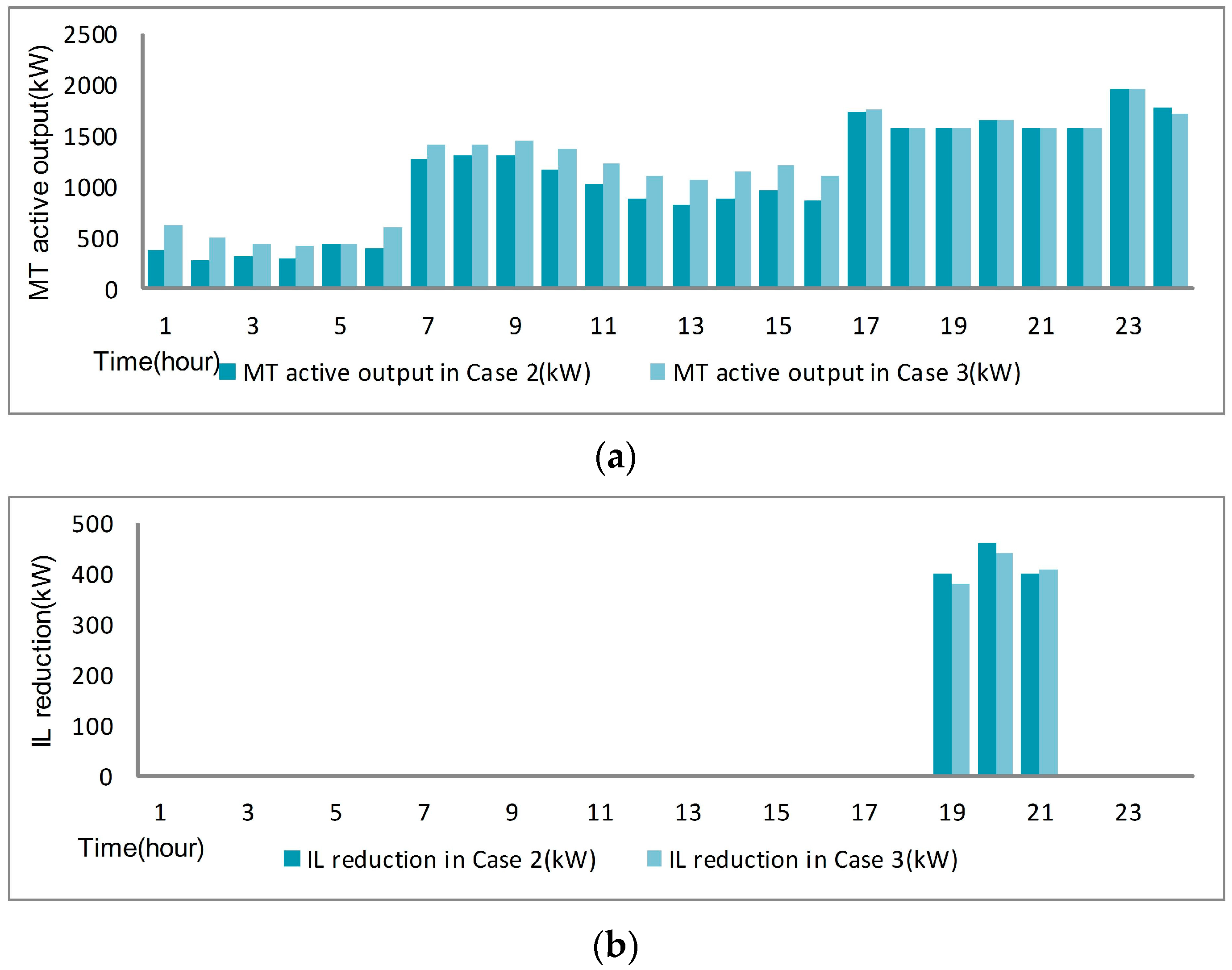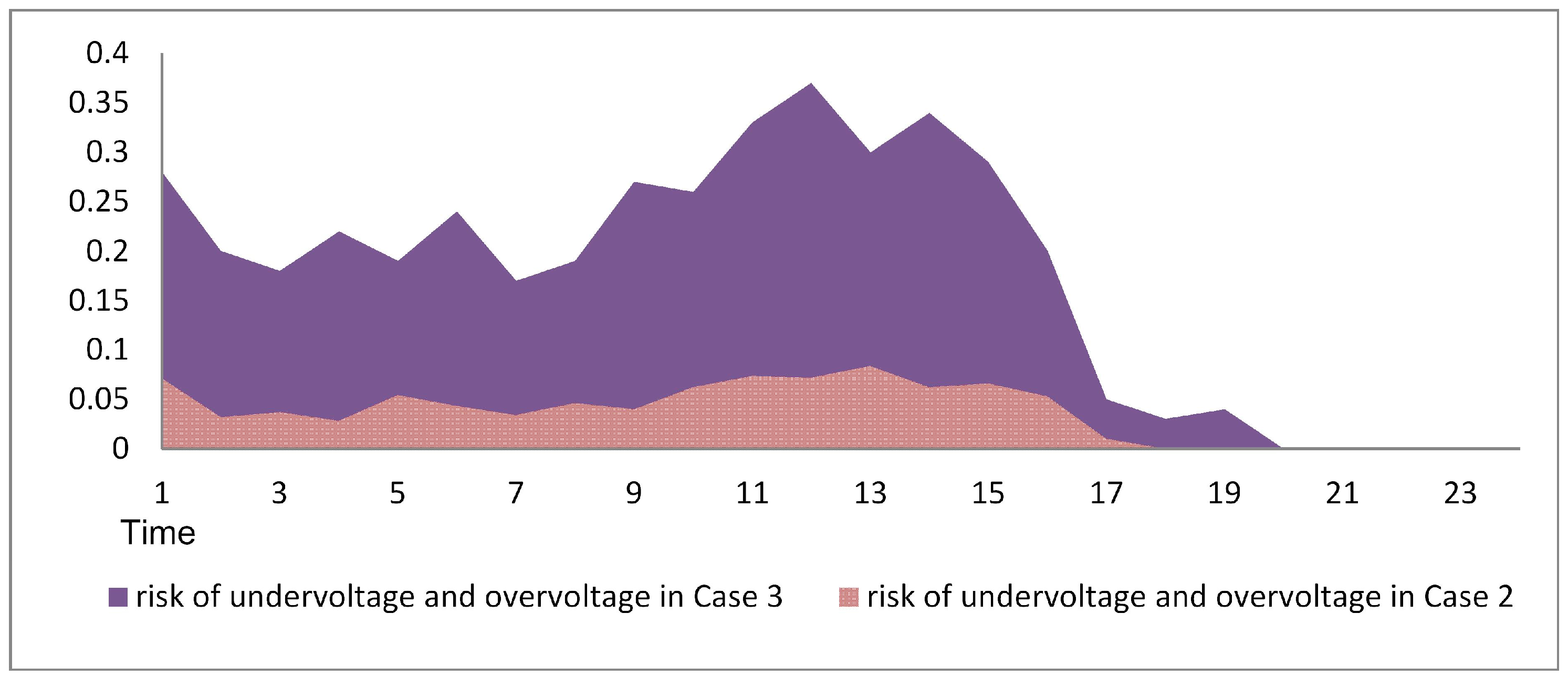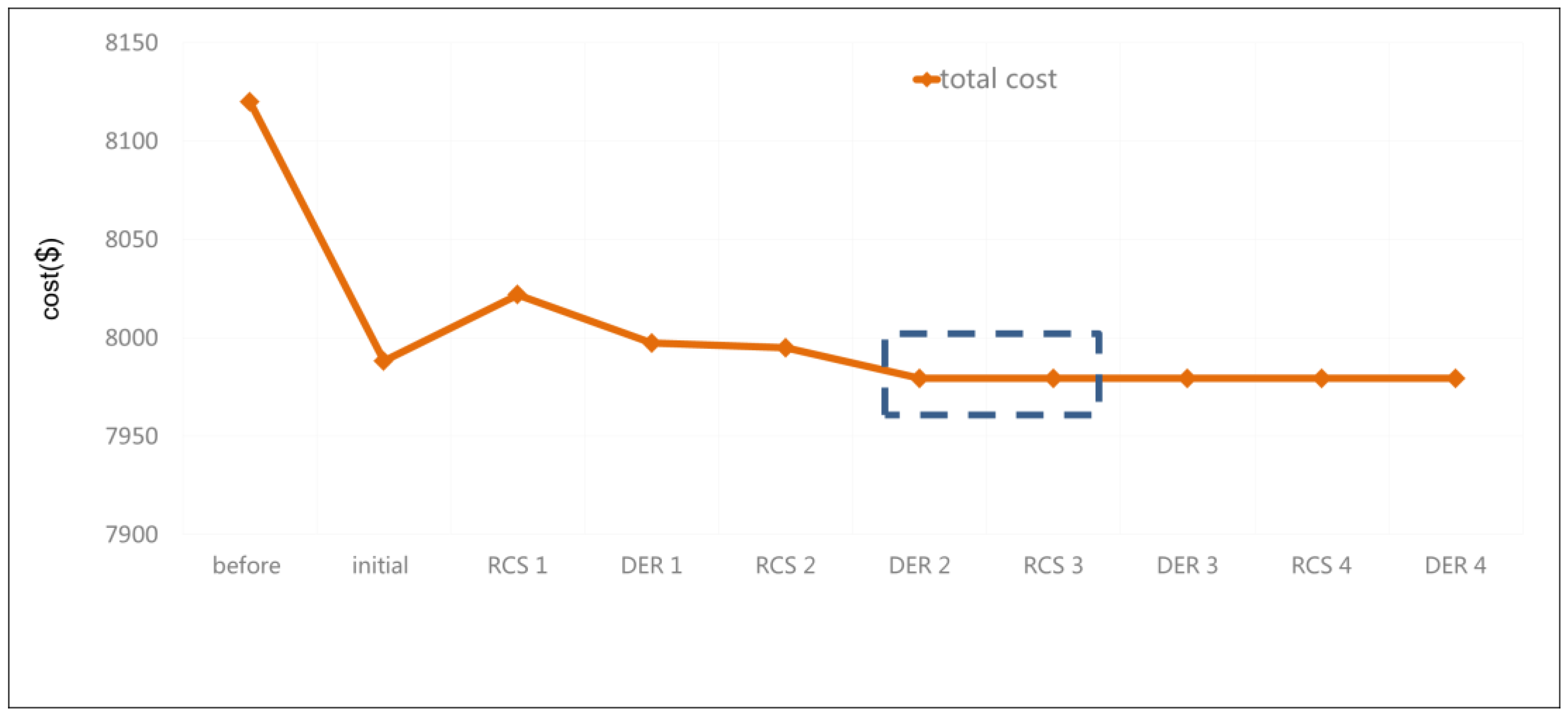1. Introduction
Recently, a large number of distributed energy resources (DERs), such as distributed generation (DG), electrical energy storage (EES), and controllable loads (CLs), are being placed in medium-voltage distribution networks for energy conservation, emissions reduction and environmental protection [
1]. With these DERs, information and communication technologies (ICT) and power electronics-integrated devices have rapidly developed in the distribution networks, which thus have evolved into active distribution networks (ADNs). However, the changes bring new risks for ADNs in some respects, such as communication network security [
2], operation of integrated devices [
3], predictive maintenance [
4] and systematic optimal operation [
5]. Among these respects, for a distribution system operator (DSO), the risk of systematic optimal operation is a priority and a main task needed to be resolved.
Regarding systematic optimal operation, the main risk is the variability and limited predictability of renewable energy generations (REGs), including wind turbines (WTs) and photovoltaics (PVs), which bring uncertainties to distribution networks [
6]. The difficulty of scheduling for DSO is increased due to the randomicity of REGs. On the other hand, controllable DERs, such as micro-turbines (MTs) and interruptible loads (ILs), can be used to optimize power flow. In order to eliminate the risk and take full advantage of DERs, the concept of ADN management (ADNM) has emerged to achieve a cost-effective and safe operation in ADNs [
7].
ADNM includes several respects, such as active power scheduling, network reconfiguration, reactive power control and control of voltage regulation devices. In most literatures about reactive power control and control of voltage regulation devices [
8,
9], reactive power of DERs is controlled under a given optimal active power. Therefore, regarding day-ahead optimal scheduling problem, active power scheduling is a priority to meet the active power needs of loads and provide the optimal active power results for reactive power optimization. In an ADN, active power scheduling adjusts the outputs of controllable DERs, based on which the risks of overvoltage are eliminated and network losses are reduced [
10]. Network reconfiguration is an important means to achieve an optimal operation by adjusting network topologies for ADNM, based on which loads can be balanced between lines [
11]. Both network topologies and DER outputs can be optimized to improve the power flow and achieve system support in a day-ahead energy market [
12]. In addition, remotely controlled switches (RCSs), which can realize network reconfiguration, should be considered in ADNM because the utilization efficiency of distribution network assets can be improved and the upgrade of distribution networks can be delayed based on the coordination between RCSs and DERs. Therefore, it is necessary to integrate distribution network reconfiguration with active management of DERs.
Network reconfiguration and DER scheduling were considered separately in the majority of literatures, and few of them realized the coordination optimization of RCSs and DERs. In [
13,
14], network reconfiguration was implemented in a distribution network with uncontrollable DGs. Reference [
13] presented a method to solve the network reconfiguration problem in the presence of DG with an objective of minimizing real power loss and improving voltage profile in distribution system. Reference [
14] considered uncontrolled DGs’ influence on distribution network reconfiguration, and a probabilistic power flow based on the point estimate method was employed to include uncertainty in WTs output. In terms of DERs operation control, taking microgrid as research object, reference [
15] proposed a microgrid optimal scheduling model to minimize the microgrid total operation cost which comprises the generation cost of DERs and cost of energy purchase from the main grid. From the perspective of ADN, reference [
16] set up an optimization model scheduling DERs’ outputs on day-ahead and intra-day time scales.
References [
17,
18,
19] combined network reconfiguration and DERs scheduling to optimize day-ahead power flows, however, all of them optimized DER outputs and network topologies based on deterministic outputs of REGs, without considering high REG forecast errors [
20], which may result in overvoltage risks in actual operation. Reference [
17] presented a two-stage energy coordination scheduling algorithm, which showed that the coordination of flexible network topology with the continuous active management of energy resources allowed improving the efficiency of power delivery in ADN. On the basis of references [
17,
18] distributed energy storage was added into the energy scheduling model. An operational scheduling framework was proposed to optimally control active elements of the network and effectively utilize the hourly network reconfiguration capabilities, seeking to minimize the day-ahead total operation costs in reference [
19], and the proposed model was formulated as a mixed-integer nonlinear problem and tackled with the genetic algorithm.
The day-ahead coordinated optimization of RCSs and DERs is very difficult to solve through the mentioned methods, such as optimal power flow (OPF) algorithm [
17,
18] and genetic algorithm [
19], considering REG forecast errors. That is because the proposed problem is a complex multi-period mixed integer nonlinear optimization (MP-MINLO), in which both continuous (DERs) and discrete (RSCs) variables in 24 h are included, and solution space will increase geometrically [
21]. The MP-MINLO problem is expressed in one OPF model and solved in one step including all the variables for 24 h in [
17,
18,
19] and it is hard to find the optimal solution without effective methods to reduce the solution space. Moreover, REG forecast errors makes the proposed problem into a stochastic active power scheduling problem and the methods mentioned in [
17,
18,
19] are hard to resolve a stochastic optimization problem.
Regarding the above questions, the original contributions of this work are as follows:
- (i)
Day-ahead active power scheduling in ADNs coordinated with network reconfiguration considering REGs forecast errors is realized in this paper. REG outputs are described through multi-state models according to REGs’ forecast errors, and the difficulty of the modeling and solving can be reduced. The randomicity of REG outputs is solved by chance constrained programming (CCP), and optimal results satisfying a certain confidence level can be achieved, which can reduce operation risks effectively.
- (ii)
A hierarchical coordination optimization method is proposed to solve the MP-MINLO problem with randomness, in order to achieve an optimal solution of network topologies and DER outputs. A three-level hierarchical optimal model based on CCP is established for 24 h. The first level is initial optimization, in which controllable DG outputs, shedding powers from ILs and network topologies are optimized statically in each hour. Optimization results are served as the initial values of other two levels. In the second level, the RCS states are optimized by dynamic network reconfiguration considering the limited number of RCS switching actions in 24 h, so as to avoid frequent RCS switching actions. The third level is DER optimization, in which the controllable DGs outputs and the shedding powers from ILs are adjusted according to the network topologies obtained from the second level. Then multiple iterations are needed between the second and the third level to acquire the optimal results of DER outputs and RCS states. Finally, the hybrid particle swarm optimization algorithm is employed to solve the proposed model.
The proposed multi-level method for a large number of periods divided the problem according to different physical characteristics of RCSs and DERs: RCSs are discrete variables and the maximum number of its switching actions is limited in one day on account of the wear and tear on RCSs and loop current when switching, while DERs are continuous variables and their outputs can be adjusted frequently in each hour. Initial optimization can improve searching efficiency and narrow the solution space effectively. RCSs and DERs optimizations optimize discrete and continuous variables respectively, so dimension of variables is decreased. Continuous and discrete variables are optimized separately in an efficient way.
The rest of this paper is organized as follows:
Section 2 presents a calculation method for dynamic active power of REGs considering forecast errors.
Section 3 addresses the proposed hierarchical coordination optimization model. The optimization algorithm for solving the model is provided in
Section 4. Case studies and numerical results are given in
Section 5. Finally, the paper is concluded in
Section 6.
3. Hierarchical Coordination Optimization Model Based on CCP
DER outputs and RCS states in 24 h are optimized considering the forecast errors of REGs. However, the proposed problem is a complex MP-MINLO problem, which is hard to solve with a huge solution space. Moreover, the multiple states of REG active power outputs make the problem more complex. For one feasible solution, the state number of REG active power outputs will increase exponentially due to the multiple periods considering random fluctuations. For example, there are
M states for REG outputs in each hour, then there are
M^24 states in one day if we solve the problem in one step as in [
17,
18,
19]. Therefore, RCSs and DERs cannot be optimized in one step and a hierarchical coordination optimization model based on CCP is established by three steps.
Firstly, an initial optimization model is established to preliminarily optimize DER outputs and RCS states statically in each hour. However, the hourly optimal results of RCS states may cause frequent switching. Therefore, RCS states need to be optimized secondly considering a limited switching number in one day. Thirdly, DER outputs are optimized based on the optimal result in RCS optimization, in order to mitigate the extra cost caused by the updated RCS states. Finally, the RCS optimization and DER optimization iterate mutually until convergence criterion is achieved, when the optimal results of RCS and DER optimization won’t change with iterations. CCP is adopted to deal with the multi-state models of REG outputs, and address the randomness due to REG forecast errors. The flowchart of the proposed hierarchical coordination optimization is shown as
Figure 1.
In real implementation, the day-ahead active power scheduling method proposed in this paper is located at the ADNM control center and is implemented by DSOs. DSOs acquire RCS initial states, day-ahead forecast load, the maximum shedding active power from ILs, day-ahead forecast outputs of REGs, day-ahead bids of controllable DGs through upload communication networks. According REG forecast errors, day-ahead forecast outputs of REGs are processed by the multi-state model. Then the optimal results can be achieved in multi-level coordination solver by the hierarchical coordination optimization method based on CCP. Taking the optimal results as the dispatch instructions, DSOs delivery the dispatch instructions to the controllable devices, including DER outputs and RCS states in the next 24 h, by the download communication networks. REGs generate active power according to their day-ahead forecast outputs in order to take full advantages of renewable energies and reduce carbon emissions. Day-ahead reactive power dispatch and real-time control, which also are important modules in the ADNM control centre, are implemented after day-ahead active power scheduling. Providing the day-ahead dispatch instructions for real-time control, day-ahead scheduling is the basis of real-time control. Real-time control updates the day-ahead dispatch instructions and determines the actual operations of controllable resources. The practical implementation of day-ahead active power scheduling is shown as
Figure 2.
3.1. Initial Optimization
Based on the multi-state models of WT-PV outputs in each hour, the controllable DGs outputs, the shedding powers from ILs and the RCS states of each hour are optimized, respectively, taking the operation costs of distribution companies (DISCOs) as optimization objective. The operation costs contain the cost of power purchases from the grid (
), cost of power purchases from DGs (
), cost of compensation DGs (
) and cost of compensation ILs (
). Chance constrained programming [
26] is adopted to deal with the multi-state models of WT-PV outputs. CCP can be used to solve the optimization problem with uncertain factors under the given confidence level, which is suitable for solving the scheduling problem in this paper that takes the uncertain outputs of REGs into consideration.
In
t period, the objective is formulated as follows:
The constraints are as follows:
- (1)
Probability constraint of the objective
where
x is the decision variable, including the controllable DGs outputs, the shedding powers of ILs and the RCS states (open or closed);
is the state variable in the multi-state system;
is the maximum number of state variables;
is the operation cost in state
;
is the probability when the condition in
is satisfied; α is the confidence level;
is the minimum value when the probability level of
is more than α;
is one hour in this paper;
is the active power purchases from the grid in
t period;
is the unit cost of the active power purchases; G is the set of DGs including controllable DGs and uncontrollable ones;
is the active power of the
mth DG in
t period that DMS allows producing on the basis of the optimization result;
is the unit cost of the active power purchases from the
mth DG;
is the bid of active power;
is the compensation cost for cutting 1 kWh of the
mth DG; C is the set of ILs;
is the shedding power from the
vth IL in
t period;
is the compensation cost for cutting 1 kWh of the
vth IL;
is the selling cost of DISCOs in
t period.
- (2)
Probability constraint of branch power:
where
is the active power of branch
in state
;
is the maximum power of branch
;
is the confidence level of branch power.
- (3)
Probability constraint of node voltage:
where
is the voltage of node
i in state
;
and
are the maximum and minimum voltage of node
i respectively;
is the confidence level of node voltage.
- (4)
Constraint of energy balance:
where
is the set of controllable DGs, and
is the set of uncontrollable ones;
is the active power output of the
th controllable DG in
t period, and
is the output of the
th uncontrollable one;
is the total load in
t period;
is the network loss in
t period.
- (5)
Constraint of active and reactive power balance:
where
,
are active and reactive power injection of bus
i;
and
are voltages of
i and
j;
and
are real part and imaginary part of admittance matrix;
is phase angle difference between
i and
j.
- (6)
Constraint of the controllable DG outputs:
where
and
are the minimum and maximum output of the
th controllable DG in
t period, respectively. In real implementation, the 24-h maximum active power outputs of controllable DGs are set as their day-ahead bids of active power provided by the DG owners.
- (7)
Constraint of the exploitation of ILs:
where
t’ is the period when load is heavy; where
and
are the minimum and maximum shedding active power from the
vth IL in
t’ period, respectively.
- (8)
Constraint of power purchases from the grid:
where
and
are the minimum and maximum active power purchases from the grid in
t period.
- (9)
Constraint of network topology:
After reconfiguration, the network is still connected radially without the presence of islanding.
3.2. RCS Optimization
The initial optimization results are the ideal ones without considering the limited number of RCS switching actions, however frequent switching actions will increase the wear and tear on RCSs, and the loop closing operation during the course of reconfiguration may lead to larger loop current [
27]. Hence, RCSs cannot be operated frequently in one day, and the RCS states need to be re-optimized with the constraint of the maximum number of RCS switching actions in 24 h [
28].
First of all, the periods with the same RCS states are merged according to the initial optimization results, as a consequence,
T periods are combined into
L new ones (
). Then considering the limited number and cost of RCS switching actions, the network topologies are adjusted according to the initial optimization results in the merged periods. A dynamic reconfiguration network model is established taking the costs of network loss and switching action as optimization objective:
where
is the total number of RCSs;
T is the period number, set as 24 in this paper;
is the number of the merged periods;
is the cost of one switching action;
is the state of the
kth RCS in
period, and
means open,
means closed.
The constraints are as follows:
- (1)
Constraint of the maximum number of RCS switching actions:
where
is the maximum number of single RCS switching actions;
is the maximum number of total RCS switching actions.
- (2)
Constraint of node voltage:
- (3)
Constraint of branch power:
Besides, the constraints of active and reactive power balance and network topology in RCS optimization are the same with the ones in initial optimization.
3.3. DER Optimization
The adjustment of network topologies will change the distribution and direction of power flow, which affects the optimal outputs of DERs, thus DER optimization is needed to acquire the new optimization results of DERs with the solution of RCS optimization. The outputs of controllable DGs and the exploitation of ILs in each period are optimized with an optimization objective of the operation costs of DISCOs, and CCP is employed to solve the multi-state models of WT-PV outputs.
The constraints are as follows:
Probability constraint of the objective:
where the decision variable
includes the controllable DGs outputs and the exploitation of ILs without the RCS states, which is different from initial optimization.
Besides, the other constraints of DER optimization are same with constraints (2)–(8) of initial optimization.
From the above
Section 3.1,
Section 3.2 and
Section 3.3, the hierarchical coordination optimization method can ensure an optimal solution of RCS states and DER outputs for 24 h. In initial optimization (
Section 3.1), hourly optimal solution of RCS states and DER outputs can be achieved by optimizing DER outputs and RCS states statically in each hour. However, the result of initial optimization is not the global optimal solution without considering the daily limited number of RCS switching actions. The global optimal solution can be acquired with mutual iterations of RCS optimization (
Section 3.2) and DER optimization (
Section 3.3), which takes the constraint of daily maximum number of RCS switching actions into the optimization model (
Section 3.2).
Furthermore, a fast convergence speed can be guaranteed with the proposed method. There are two main reasons for the rapid convergence. One reason is that the huge solution space of the MP-MINLO problem is narrowed effectively in initial optimization, which optimizes DER outputs and RCS states statically in each hour and serves its optimization results as the initial values of other two levels. Initial optimization improves searching efficiency of RCS optimization and DER optimization. The other reason is that the model of each level takes network losses as a part of the optimization goal, and all three levels pursue the optimal economic efficiency. As a result, the search direction of three levels is consistent, which ensures that the results can converge to the global optimal solution rapidly in process of solving. The convergence speed result is shown in
Section 5.4 with Figure 10.
